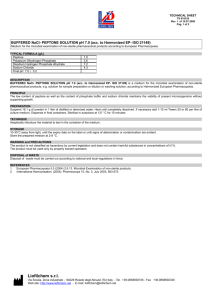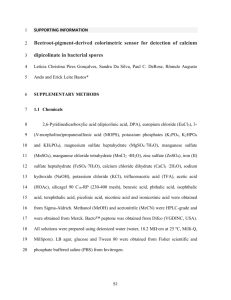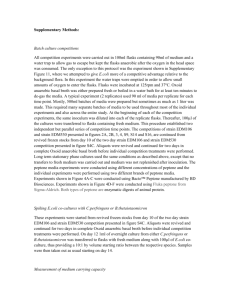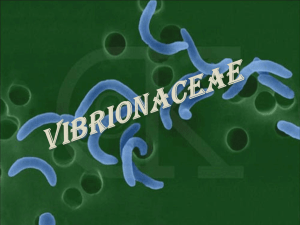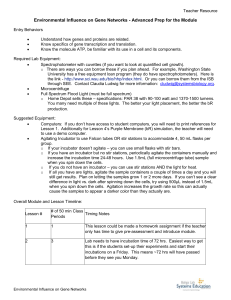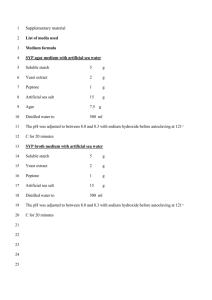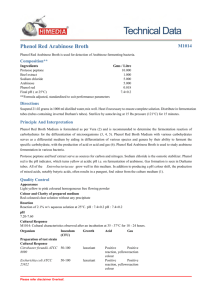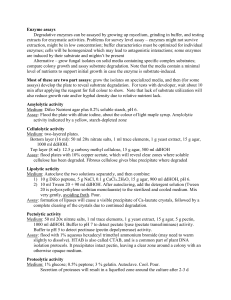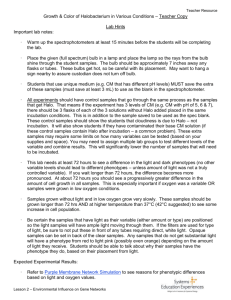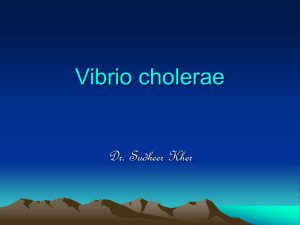Proteose Peptone
advertisement
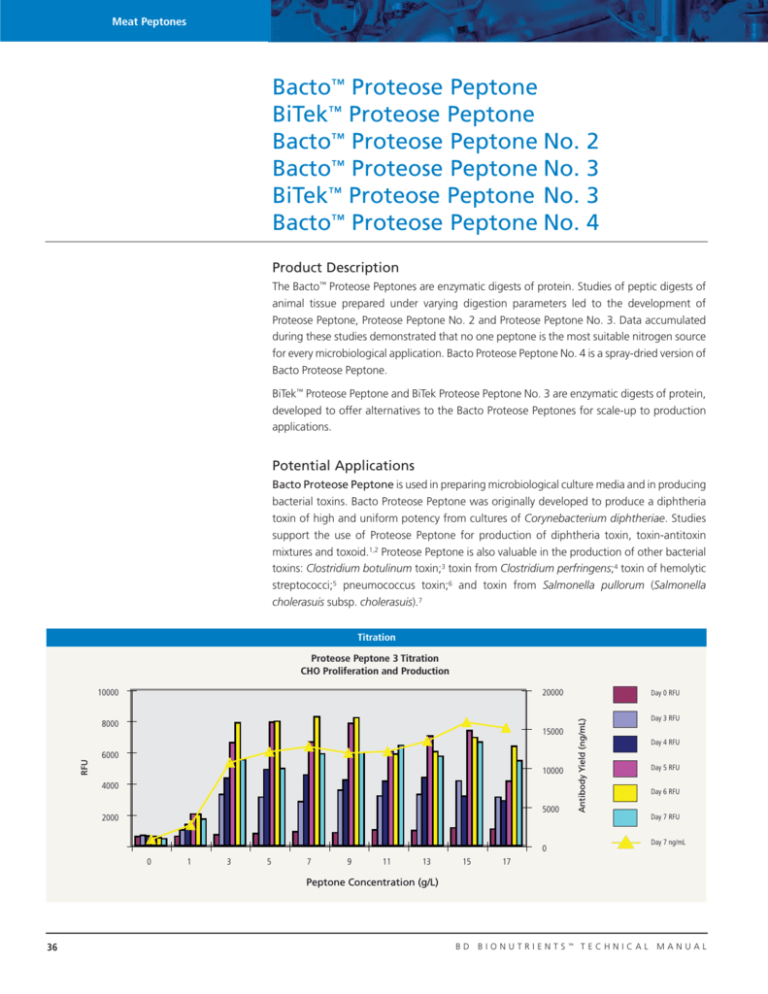
Meat Peptones Bacto™ Proteose Peptone BiTek™ Proteose Peptone Bacto™ Proteose Peptone No. Bacto™ Proteose Peptone No. BiTek™ Proteose Peptone No. Bacto™ Proteose Peptone No. 2 3 3 4 Product Description The Bacto™ Proteose Peptones are enzymatic digests of protein. Studies of peptic digests of animal tissue prepared under varying digestion parameters led to the development of Proteose Peptone, Proteose Peptone No. 2 and Proteose Peptone No. 3. Data accumulated during these studies demonstrated that no one peptone is the most suitable nitrogen source for every microbiological application. Bacto Proteose Peptone No. 4 is a spray-dried version of Bacto Proteose Peptone. BiTek™ Proteose Peptone and BiTek Proteose Peptone No. 3 are enzymatic digests of protein, developed to offer alternatives to the Bacto Proteose Peptones for scale-up to production applications. Potential Applications Bacto Proteose Peptone is used in preparing microbiological culture media and in producing bacterial toxins. Bacto Proteose Peptone was originally developed to produce a diphtheria toxin of high and uniform potency from cultures of Corynebacterium diphtheriae. Studies support the use of Proteose Peptone for production of diphtheria toxin, toxin-antitoxin mixtures and toxoid.1,2 Proteose Peptone is also valuable in the production of other bacterial toxins: Clostridium botulinum toxin;3 toxin from Clostridium perfringens;4 toxin of hemolytic streptococci;5 pneumococcus toxin;6 and toxin from Salmonella pullorum (Salmonella cholerasuis subsp. cholerasuis).7 Titration Proteose Peptone 3 Titration CHO Proliferation and Production 20000 RFU 8000 Day 0 RFU Antibody Yield (ng/mL) 10000 15000 6000 10000 4000 5000 2000 1 3 5 7 9 11 13 15 Day 4 RFU Day 5 RFU Day 6 RFU Day 7 RFU Day 7 ng/mL 0 0 Day 3 RFU 17 Peptone Concentration (g/L) 36 BD BIONUTRIENTS ™ TECHNICAL MANUAL Meat Peptones Many factors account for the suitability of Proteose Peptone for the culture of fastidious pathogens, including the nitrogen components, buffering range and the high content of proteoses. These elements create an environment beneficial to the maintenance of virulence and the elaboration of bacterial by-products, thus stock cultures are well preserved on media containing Bacto Proteose Peptone. Bacto™ Proteose Peptone may be used in culture medium for a variety of applications, including production of substances from the culture of bacteria, fungi and mammalian cells. Proteose Peptone has been utilized in a medium for producing glycosidases from Bacteroides fragilis,8 and to stimulate amyloglucosidase production by Aspergillus sp.9 It has been used to cultivate halophilic bacteria isolated from soil in Egypt for production of polymers.10 Jan et al.11 reported that Proteose Peptone as supplementation to defined medium resulted in significant increases in cell number and specific monoclonal antibody production in batch culture system. Proteose Peptone has also been used to provide nutrients for axenic culture of amoeba.12 BiTek™ Proteose Peptone was developed to provide an alternative product to Bacto Peptone with growth characteristics similar to Bacto Proteose Peptone. Bacto™ Proteose Peptone No. 3 is used in preparing microbiological culture media. It is a modification of Proteose Peptone adapted for use in the preparation of chocolate agar for propagation of Neisseria species and chocolate tellurite agar for Corynebacterium diphtheriae. While investigating the nutritional values of the Proteose Peptones, Difco Laboratories found that Proteose Peptone No. 3 provides superior nutrition for fastidious microorganisms. It supports growth of streptococci, staphylococci, pneumococci, gonococci and other organisms that require a highly nutritious substrate. For example, Ifediba and Vanderberg14 BiTek™ Proteose Peptone 70 60 Area Percentage Bacto™ Proteose Peptone No. 2 is used in preparing microbiological culture media. It was originally developed for use in media for the production of diphtheria toxin. Bunney and Thomas13 reported good yield of diphtheria toxin with Proteose Peptone No. 2 in a simple peptone-sugar-sodium acetate medium. Molecular Weight 50 40 30 20 10 0 <250 Growth Curve >10k Bacto™ Proteose Peptone 60 Area Percentage Average OD at 600nm 1 5k-10k 70 1.4 1.2 2k-5k Molecular Weight 1% Bacto™ Proteose Peptone in 1.13% M9 Minimal Salts + 0.4% Glucose, BioScreen C Bacillus subtilis ATCC™ 6633 Escherichia coli ATCC 47014 Staphylococcus aureus ATCC 25923 Saccharomyces cerevisiae ATCC 287 Enterococcus faecalis ATCC 29212 250-500 500-2k Molecular Weight Range (Daltons) 50 40 30 20 0.8 10 0.6 0 <250 250-500 500-2k 2k-5k 5k-10k >10k Molecular Weight Range (Daltons) 0.4 0.2 0 1 3 5 7 9 11 13 15 17 19 21 23 25 27 29 31 33 35 37 39 41 43 45 47 49 Time in Hours ADVANCED BIOPROCESSING • THIRD EDITION 37 Meat Peptones Growth Curve Molecular Weight Bacto™ Proteose Peptone No. 2 70 1% Bacto™ Proteose Peptone No. 2 in 1.13% M9 Minimal Salts + 0.4% Glucose, BioScreen C 1 Bacillus subtilis ATCC™ 6633 Escherichia coli ATCC 47014 Staphylococcus aureus ATCC 25923 Saccharomyces cerevisiae ATCC 287 Enterococcus faecalis ATCC 29212 0.9 50 0.8 40 30 20 10 0 <250 250-500 500-2k 2k-5k 5k-10k >10k Molecular Weight Range (Daltons) Average OD at 600nm Area Percentage 60 0.7 0.6 0.5 0.4 0.3 0.2 0.1 Molecular Weight BiTek™ Proteose Peptone No. 3 0 1 3 5 7 9 11 13 15 17 19 21 23 25 27 29 31 33 35 37 39 41 43 45 47 49 Time in Hours 70 Area Percentage 60 50 report that Proteose Peptone No. 3 in addition to calf serum was used as an inexpensive replacement for human serum in cultivation of Plasmodium falciparum, the causative agent of human malaria. Cell culture manufacturers have found significant yield improvements in using Proteose Peptone No. 3. 40 30 20 BiTek™ Proteose Peptone No. 3 was developed to provide an alternative product to Bacto Proteose Peptone No. 3 with growth characteristics similar to Bacto Proteose Peptone No. 3. 10 0 <250 250-500 500-2k 2k-5k 5k-10k Molecular Weight Range (Daltons) >10k Bacto™ Proteose Peptone No. 4 is a spray-dried version of Bacto Proteose Peptone. It offers the same beneficial nutrients as Proteose Peptone for growth promotion and toxin production with a wide range of fastidious microorganisms. Availability Product Description Cat. No. Qty. Bacto™ Proteose Peptone . . . . . . . . . . . . . . . . . . . . . . . . . . . . . . . . . . . 211684 . . . . . . 500 g Bacto™ Proteose Peptone . . . . . . . . . . . . . . . . . . . . . . . . . . . . . . . . . . . 212010 . . . . . . 10 kg BiTek™ Proteose Peptone. . . . . . . . . . . . . . . . . . . . . . . . . . . . . . . . . . . . 253310 . . . . . . 10 kg Bacto™ Proteose Peptone No. 2. . . . . . . . . . . . . . . . . . . . . . . . . . . . . . . 212120 . . . . . . 500 g Bacto™ Proteose Peptone No. 2. . . . . . . . . . . . . . . . . . . . . . . . . . . . . . . 212110 . . . . . . 10 kg Bacto™ Proteose Peptone No. 3. . . . . . . . . . . . . . . . . . . . . . . . . . . . . . . 211693 . . . . . . 500 g Bacto™ Proteose Peptone No. 3. . . . . . . . . . . . . . . . . . . . . . . . . . . . . . . 212220 . . . . . . 2 kg Bacto™ Proteose Peptone No. 3. . . . . . . . . . . . . . . . . . . . . . . . . . . . . . . 212230 . . . . . . 10 kg Bacto™ Proteose Peptone No. 3. . . . . . . . . . . . . . . . . . . . . . . . . . . . . . . 211692 . . . . . . 50 kg BiTek™ Proteose Peptone No. 3 . . . . . . . . . . . . . . . . . . . . . . . . . . . . . . . 253720 . . . . . . 25 kg Bacto™ Proteose Peptone No. 4. . . . . . . . . . . . . . . . . . . . . . . . . . . . . . . 211715 . . . . . . 10 kg 38 BD BIONUTRIENTS ™ TECHNICAL MANUAL Meat Peptones Growth Curve Molecular Weight Bacto™ Proteose Peptone No. 3 1% Bacto™ Proteose Peptone No. 3 in 1.13% M9 Minimal Salts + 0.4% Glucose, BioScreen C 70 1.4 Area Percentage 1.2 Average OD at 600nm 60 Bacillus subtilis ATCC™ 6633 Escherichia coli ATCC 47014 Staphylococcus aureus ATCC 25923 Saccharomyces cerevisiae ATCC 287 Enterococcus faecalis ATCC 29212 1 50 40 30 20 0.8 10 0.6 0 <250 250-500 500-2k 2k-5k 5k-10k >10k Molecular Weight Range (Daltons) 0.4 0.2 Molecular Weight 0 1 3 5 7 9 11 13 15 17 19 21 23 25 27 29 31 33 35 37 39 41 43 45 47 49 Bacto™ Proteose Peptone No. 4 Time in Hours 70 Physical Characteristics Bacto™ Proteose Peptone appears as tan, free-flowing granules. BiTek™ Proteose Peptone is a tan, free-flowing, homogeneous powder. Area Percentage 60 50 40 30 20 Bacto™ Proteose Peptone No. 2 appears as tan, free-flowing granules. 10 Bacto™ Proteose Peptone No. 3 appears as golden tan, free-flowing granules. 0 <250 BiTek Proteose Peptone No. 3 is a light beige, free-flowing, homogeneous powder. ™ 250-500 500-2k 2k-5k 5k-10k >10k Molecular Weight Range (Daltons) Bacto™ Proteose Peptone No. 4 is a light beige, free-flowing, homogeneous powder. References 1. Kirkbride, Berthelsen and Clark. 1931. Comparative studies of infusion and infusion-free diphtheria toxin in antitoxin production and in standardization by the flocculation, subcutaneous, and intracutaneous tests. J. Immunol. 21:1-20. 2. Hazen and Heller. 1931. Further studies upon the effect of various carbohydrates on production of diphtheria toxin with special reference to its flocculating titer and final pH. J. Bacteriol. 23:195-209. 3. Nelson. 1927. The relationship between the intracellular globulin and the toxin of C. botulinum. J. Infect. Dis. 41:9-12. 4. Mollby and Holme. 1976. Production of phospholipase C (alpha-toxin), haemolysins and lethal toxins by Clostridium perfringens types A to D. J. Gen. Microbiol. 96:137-144. 5. Kirkbride and Wheeler. 1926. Studies of the toxins of the hemolytic streptococci associated with scarlet fever. J. Immunol. 11:477-497. 6. Kneeland and Dawes. 1932. Studies on the common cold: V. The relationship of pathogenic bacteria to upper respiratory diseases in infants. J. Exp. Med. 55:735-744. 7. Hanks and Rettger. 1931. Bacterial endotoxin; search for a specific intracellular toxin in S. pullorum. J. Immunol. 22:283-314. 8. Berg, Nord and Wadstrom. 1978. Formation of glycosidases in batch and continuous culture of Bacteroides fragilis. Appl. Environ. Microbiol. 35:269-273. 9. Mamo and Gessesse. 1999. Production of raw-starch digesting amyloglucosidase by Aspergillus sp. GP-21 in solid state fermentation. J. Ind. Microbiol. Biotechnol. 22:622-626. 10. Hezayen, Rehm, Eberhardt and Steinbuchel. 2000. Polymer production by two newly isolated extremely halophilic archaea: application of a novel corrosion-resistant bioreactor. Appl. Microbiol. Biotechnol. 54:319-325. 11. Jan, Jones, Emery and Al-Rubeai. 1994. Peptone, a low-cost growth-promoting nutrient for intensive animal cell culture. Cytotechnol. 16:17-26. 12. Shukla, Kaul and Mehlotra. 1989. Development of improved media for axenic cultivation of Acanthamoeba culbertsoni, Singh and Das 1970. Indian J. Exp. Biol. 27:785-791. 13. Bunney and Thomas. 1936. Diphtheria toxin-production on broths made from dried complete media. J. Immunol. 31:95-102. 14. Ifediba and Vanderberg. 1980. Peptones and calf serum as a replacement for human serum in the cultivation of Plasmodium falciparum. J. Parasitol. 66:236-239. ADVANCED BIOPROCESSING • THIRD EDITION 39
